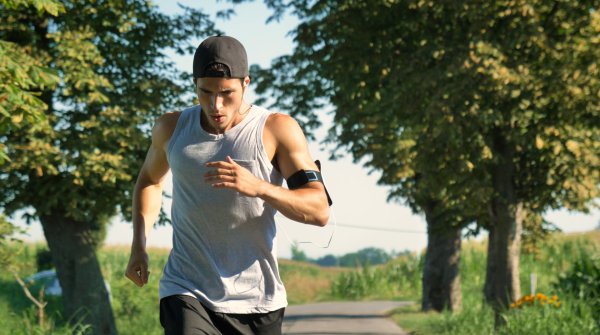With trail running, also called landscape, folk or forest running, the local conditions of nature are used for training. The parks and riverside trails of major cities come into question, as do the trails in the surrounding forests or fields. In contrast to long-distance or cross-country running, trail running does not have a set course. Ground conditions and trail length vary - just put on the right trail running shoes and off you go.
- Trail running as a change from jogging
- Trail running goes everywhere
- Trail running means "back to the roots"
- Trail running is considered close to nature
- Trail running is free
- Trail running is easy on the joints
- Trail running uses many muscle groups
- Everyone trains at their level
- Trail running allows a new look at familiar places
- Connection with other sports
Jogging is too monotonous in the long run? Then let's get out of the same old loop in the city and into the surrounding area: trails in parks, hiking trails in meadows and forests, trim trails, forest roads or gravel tracks are all suitable for trail running. Uphills and downhills are considered natural obstacles and are credited as an additional boost to fitness.
To start trail running, you don't need smooth roads, a treadmill or a sports field with laid-out tracks. On every coast, in every grove, in every field there are trails that can be included in outdoor running. Whether on vacation or at home, trail running goes everywhere.
For those who don't like the hype around fashion-conscious and tech-supervised gear while jogging with full connectivity via fitness smartphone apps, headphones, heart rate monitors and GPS goes too far, will find trail running an original way of running. It's no accident that this sport is also known as popular running. However, all the developments of modern running can also be combined with trail running, if desired.

In times of eco and bio, trail running is considered a sustainable answer to cross-country running and long-distance training at the sports club. No courses need to be marked out or sports fields built. Trail running takes place on the already existing paths and trails of the environment. In the best case it can start directly in front of the door. If asphalted roads are included in the beginning, before the next forest path or park is reached, one speaks of Urban Trail Running or Citytrail.
Whoever doesn't sign up for official trail running events doesn't have to pay anything for running on public trails: no club membership, no course fee. That saves costs. You remain flexible: in terms of time, location and also training duration.
Compared to training on asphalt roads or the sports field with synthetic tracks, hard pitches made of ash or cinders, trail running on lightly paved meadow and forest paths is much gentler on the joints. Those who can include sandy trails in their training run particularly smoothly. This also applies to so-called fin tracks, which are lined with sawdust or bark mulch.
Sinking into soft ground or onto gravel and scree trails when trail running means, on the one hand, a more intensive workout for feet and legs. On the other hand, the sense of balance is put under greater strain, activating many muscle groups. This also trains coordination and concentration.
Trailrunning means freedom of choice: whether with or without inclines, whether even or changing ground - everyone trains at their level of difficulty. And who (times) can not muster the time for extensive cross-country training: Trail running also allows you to train extremely intensively on challenging trails for a shorter period of time.

Trail running improves local knowledge. You open up unknown paths, which promises variety and possibly interesting discoveries not far from your own front door. Whether industrial wastelands or natural beauty spots, there are exciting things to see everywhere. And if you meet other people while trail running, they are probably not the same as on the always same jogging round.
Trail running can be understood as a pure long-distance run in the countryside or as an extended obstacle course. The route can be chosen by everyone according to his preferences and level of fitness. Much equipment is not needed. Normal running gear is usually fine. Only the right trail running shoes are needed. From a leisurely endurance run along the river bank to a multi-day crossing of the Alps over hill and dale - trail running has many facets. Cross trails are mountain runs that take place on trails. The most extreme form of trail running is the trail adventure. This involves running (off trail) in steep alpine terrain on scree and rock over streams and fallen trees.
Trail running offers all nature lovers a good alternative to jogging and brings variety in the design of the running schedule. Instead of asphalt and crowded streets, trail running takes you into nature and makes you more focused on running. This also helps you switch off mentally and frees your mind from stressful everyday life.
Finally, we answer frequently asked questions about trail running.
Trail means as much as path or way. Basically, everything is considered a trail that is not a road or asphalt, so forest or meadow paths for example.
Sportswear is the only thing you need for trail running on easy trails. On difficult trails, it is also recommended to have a change of clothes, a small first aid kit and your cell phone in your pocket. On a longer tour, the right food (e.g. snacks) and weatherproof clothing should not be missing.
.
- ISPO awards
- Mountain sports
- Bike
- Design
- Retail
- Fitness
- Health
- ISPO Job Market
- ISPO Munich
- ISPO Shanghai
- Running
- Brands
- Sustainability
- Olympia
- OutDoor
- Promotion
- Sports Business
- ISPO Textrends
- Triathlon
- Water sports
- Winter sports
- eSports
- SportsTech
- OutDoor by ISPO
- Heroes
- Transformation
- Sport Fashion
- Urban Culture
- Challenges of a CEO
- Trade fairs
- Sports
- Find the Balance
- Product reviews
- Newsletter Exclusive Area
- Magazine







